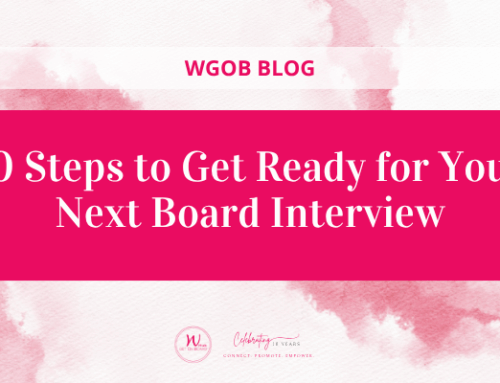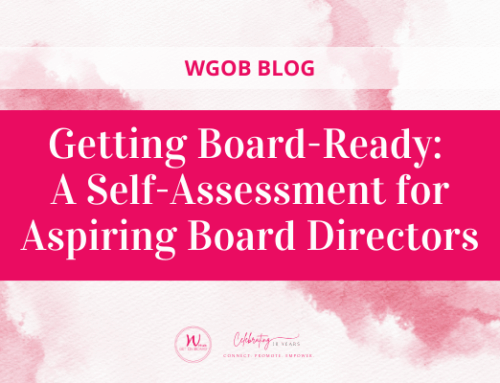So, you are excited you received an email or phone call asking if you would consider a board opportunity. The steps you take to determine whether you are interested or not should be particularly strategic when exploring new board opportunities.
The first step, do your due diligence in making sure you understand the company, culture, any conflicts that exist, and why you were considered for the board opportunity. Refer to my blog on building your board profile here: https://womengetonboard.ca/building-your-board-profile.
Make sure you know the companies or industries that you are interested in.
Review their values, mission and strategy. Do they align with your skills, experiences and values? Will you add value?
I always evaluate Board opportunities in three ways:
1. How can I add value?
2. Do I have a personal statement of the attributes I can bring to the board?
3. How can I use my network to make meaningful connections to grow the business?
The second step, if you are interested the opportunity, you should request more information early on, including:
· A detailed board position specification (profiles the skills/expertise the board is looking for and the board recruitment process)
· A copy of the corporate calendar (outlining board meetings and committee meetings)
· Information regarding what committee you would be considered for
· Financials and who the other board members are, if the company is private
· Information regarding why the company is recruiting new board members (renewal or additional members?)
· Potential connections to any of the board members through your network (learn more about network mapping your way onto a board in this blog post: https://womengetonboard.ca/network-mapping-your-way-onto-a-board)
Joining a board is about fit and style, and the board wants to make sure that your style will align with theirs. To help them decide, think about your network and how you might be connected to any one of the existing board members. This is what I call “network mapping.” Use your network to map out how you might be connected to members of the board — the more connections you have to the board, the more comfortable they will be with your likelihood of fitting in. Don’t be afraid to ask for introductions!
The third step, you have been asked to a board interview.
Congratulations! Now that you have landed the interview what do you need to do to prepare? A board interview is similar to a job interview in that you want to put your best foot forward. Where board interviews differ is that the preparation required stems from a governance point of view rather than from a management viewpoint. My blog on preparing for a board interview provides you with ten tips to consider when preparing for a board interview: https://womengetonboard.ca/preparing-for-a-board-interview.
Now, let’s say you have gone through the above steps to determine whether you are interested in a particular board opportunity and you decide that you are not – think about how you can be gracious in saying “no”.
1. Be specific as to why you said “no.”
You could say something like, “thank you for the opportunity to be considered for the board opportunity but:”
- I am already serving on the board of several other similar companies
- I am conflicted on the corporate calendar
- I am interested in diversifying my board portfolio (see my blog: https://womengetonboard.ca/are-you-diversifying-your-board-portfolio)
- I am not interested in this particular industry
- This opportunity does not align with my values
- I am not interested in the public sector/crown corporation boards
- I am over boarded – meaning you are serving on too many boards to have the time/capacity to commit to another board opportunity
2. Reposition what you are looking for instead
Take the opportunity to let your network know what you are looking for. Perhaps it is something like:
- I am interested in a company that is global and is TSX listed
- I am interested in a company that is focused on (this) particular industry
- I am interested in a company that aligns with (this) set of values
3. Offer to assist by referring 2-3 other potential board candidates
Turning down a board opportunity allows you to say something like “I appreciate the opportunity to be considered, but would be pleased to refer some other potential board candidates”. It is important to be building your own pipeline of other qualified board candidates to refer, since nothing is as important as paying it forward for others.
You should always be exploring new board opportunities, since your board portfolio should be very fluid, your board term may come up, or the company you are serving on a board for may go through an M&A transaction. It is also valuable to meet other serving corporate directors, through which you can build your own pipeline of qualified candidates that you can refer for board opportunities.







